Bolívar is a beautiful region of Venezuela filled with lush, tropical landscapes and diverse wildlife, including many species of birds. The region is home to some of the most spectacular birds in the world, including toucans, macaws, parrots, tanagers, and hummingbirds.
With its rich biodiversity, Bolívar is a paradise for birdwatchers, allowing them to observe both resident and migratory birds.
In addition to the wide variety of bird species, the region is also home to some of the most important bird sanctuaries in the world, providing a safe refuge for threatened species. Whether you’re a beginner or a seasoned birdwatcher, Bolívar has something for everyone.
13 Birds to Watch in Bolívar
Bolívar is a beautiful region of Venezuela filled with lush, tropical landscapes and diverse wildlife, including many species of birds. The region is home to some of the most spectacular birds in the world, including toucans, macaws, parrots, tanagers, and hummingbirds.
Here are 13 birds that you should not miss when visiting Bolívar:
1. Brown Pelican
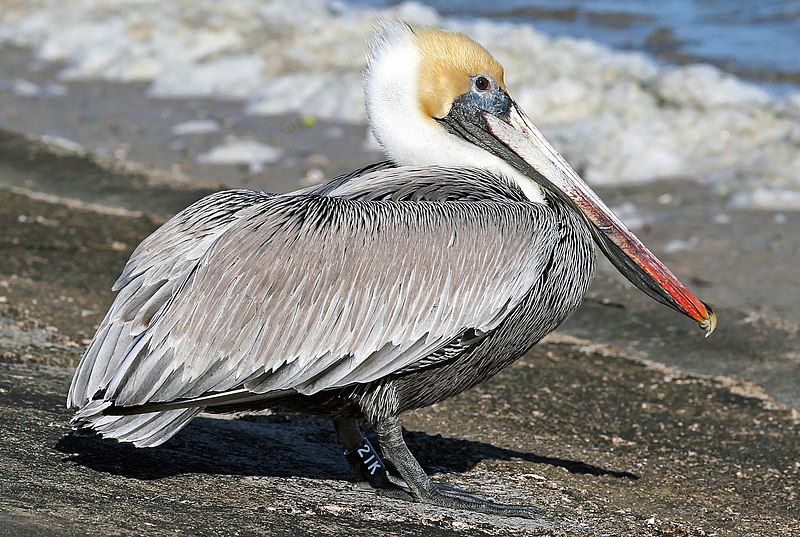
The brown pelican is a species of bird from the family Pelecanidae, found in the Americas. It is one of three species of pelicans in the Americas and one of two species that feed by diving into the water.
The brown pelican is an iconic coastal bird, with its distinctive large bill, long neck, and large, dark body. Its wingspan can reach up to 7 feet, and its large, webbed feet are perfect for swimming. It is usually seen along the coast but can sometimes be found inland.
Its diet usually consists of fish, crustaceans, and other aquatic creatures, which it catches by plunging into the water and scooping up prey with its bill.
The brown pelican has a long history of being hunted and persecuted, but its population has been increasing in recent years thanks to conservation efforts. It is now a protected species, and its numbers are slowly recovering.
| Kingdom | Animalia |
| Phylum | Chordata |
| Class | Aves |
| Order | Pelecaniformes |
| Family | Pelecanidae |
| Genus | Pelecanus |
| Species | P. occidentalis |
2. Great Egret
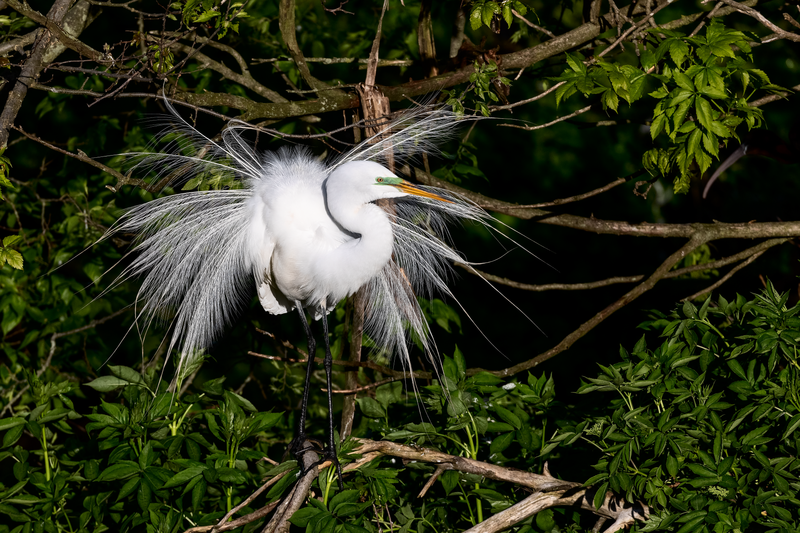
The great egret is a large bird that is found in many different places around the world. It is commonly known by many names, such as the common egret, large egret, great white egret, or great white heron.
It comprises four subspecies, which can be found in Asia, Africa, the Americas, and southern Europe. In recent years, the great egret has also begun to spread further north into Europe. The great egret is easily recognizable due to its size and white plumage.
It is typically around three feet tall and has a four to five feet wingspan. Its feathers are usually white or grey, and its legs are yellowish. Its long neck and pointed bill make it easy to spot in the wild. The great egret can be found in many different habitats.
It is often seen in wetlands such as swamps, marshes, and rivers. It is also known to inhabit shallow coastal areas as well.
It is an opportunistic feeder often seen hunting in shallow waters for small fish, frogs, and insects. The great egret is a protected species in many countries due to its declining population.
Conservation efforts have been put in place to protect its habitat and ensure its survival. As its range continues to expand, it is hoped that the great egret will thrive in its natural habitat.
| Kingdom | Animalia |
| Phylum | Chordata |
| Class | Aves |
| Order | Pelecaniformes |
| Family | Ardeidae |
| Genus | Ardea |
| Species | A. alba |
3. Great Blue Heron
The great blue heron is a majestic bird of the Ardeidae family. It can be found near the open waters of North and Central America, South America, the Caribbean, and the Galápagos Islands.
They are large wading birds, typically standing four feet tall with a wingspan of up to five and a half feet. They have a grayish-blue body, long yellow legs, and a sharp, curved bill. These birds typically hunt for fish, frogs, and other small creatures in shallow waters.
They can be seen standing atop logs or rocks, waiting patiently for their prey. Great blue herons are also known to nest in colonies near their preferred habitats. This is why they are so commonly seen near open water and wetlands.
The great blue heron is a sight to behold, and its presence is a reminder of the importance of conserving and preserving its natural habitats.
| Kingdom | Animalia |
| Phylum | Chordata |
| Class | Aves |
| Order | Pelecaniformes |
| Family | Ardeidae |
| Genus | Ardea |
| Species | A. herodias |
4. Roseate Spoonbill
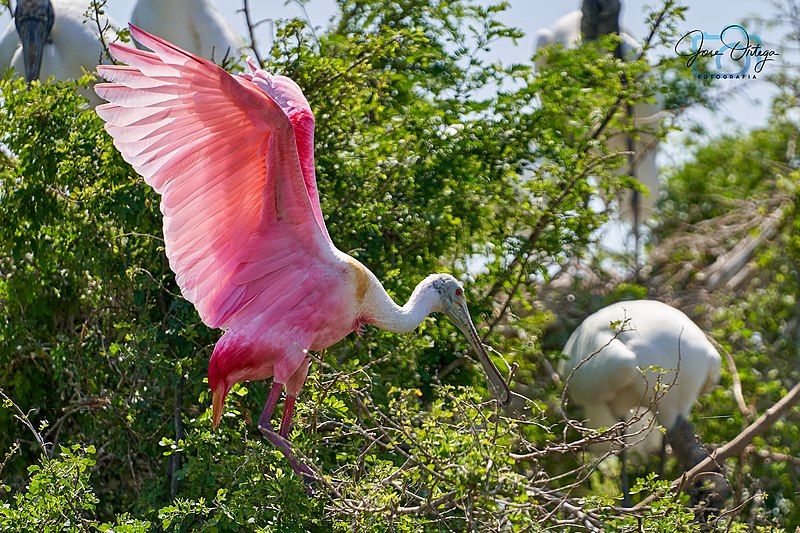
The Roseate Spoonbill is a species of wading bird that belongs to the Threskiornithidae family, which includes the ibis and spoonbill. It is native to both South and North America and typically breeds as a resident species.
The Roseate Spoonbill has a distinctive pink color derived from its diet of carotenoid pigments, such as canthaxanthin. This is the same pigment that gives the American Flamingo its pink feathers.
The Roseate Spoonbill is a gregarious bird, often seen in large flocks, and is a famous sight in many areas of its range. Its unique coloring makes it a particularly eye-catching species and an essential member of the local ecosystem.
| Kingdom | Animalia |
| Phylum | Chordata |
| Class | Aves |
| Order | Pelecaniformes |
| Family | Threskiornithidae |
| Genus | Platalea |
| Species | P. ajaja |
5. American Avocet
The American avocet is a large wader from the avocet and stilt family, Recurvirostridae. It is found in North America and spends much time foraging in shallow water or mud flats.
Its diet consists of crustaceans and insects, which it searches for by sweeping its bill from side to side in the water. This sweeping motion is a unique technique that the American avocet uses to find its prey.
It is an efficient way to locate and capture food without wasting energy. The American avocet has a striking appearance: its long, thin legs, distinctive black and white plumage, and long, curved bill.
Its reddish-brown head and neck contrast with the white body, and its long, black tail feathers add color.
Its legs also have black and white patches, which give it a striking appearance. The American avocado is an integral part of the North American ecosystem, as it helps to keep the local insect and crustacean population in check.
It also plays a role in the food web, as other species consume its prey. The American Avocet is an integral part of wetland habitats and is a valuable species in North America.
| Kingdom | Animalia |
| Phylum | Chordata |
| Class | Aves |
| Order | Charadriiformes |
| Family | Recurvirostridae |
| Genus | Recurvirostra |
| Species | R. americana |
6. Yellow-billed Cuckoo
The yellow-billed cuckoo is a large bird belonging to the cuckoo family. It is found across the United States, especially in the southern part. It is commonly referred to as “rain crow” or “storm crow” by the local people in the south.
This name likely reflects the bird’s habit of calling out on hot days, often foretelling the coming of rain or thunderstorms. This behavior has earned it the reputation of being an excellent weather predictor.
The bird is also known for its distinct call, coos and low-pitched hoots. Its call is often a sign of the coming of spring.
The yellow-billed cuckoo is an integral part of the southern United States’ ecosystem, and people need to recognize its importance and take measures to protect and conserve it.
| Kingdom | Animalia |
| Phylum | Chordata |
| Class | Aves |
| Order | Cuculiformes |
| Family | Cuculidae |
| Genus | Coccyzus |
| Species | C. americanus |
7. White Ibis
The American white ibis is a species of bird belonging to the Threskiornithidae family of ibises. This species can be found throughout the coastal regions of the United States, stretching from Virginia along the Gulf Coast and south to the tropics of the New World.
The American white ibis has a distinct white body, long curved bill, and distinctive bright red facial skin. A social bird often feeds in large flocks and nests in colonies.
It can often be found in wetlands, mudflats, and coastal marshes, where it feeds on various small animals, including fish, frogs, and insects.
The American white ibis is an integral part of the coastal ecosystem, providing an important food source for other species and helping maintain the food web’s balance.
| Kingdom | Animalia |
| Phylum | Chordata |
| Class | Aves |
| Order | Pelecaniformes |
| Family | Threskiornithidae |
| Genus | Eudocimus |
| Species | E. albus |
8. Ruddy Turnstone
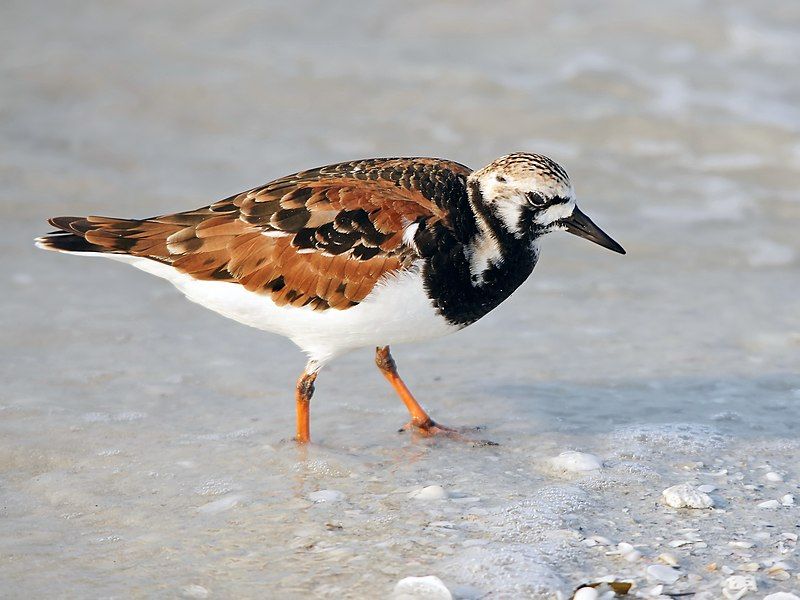
The ruddy turnstone is a species of wading bird found in many parts of the world. It belongs to the genus Arenaria and is composed of two turnstone species. It is a small bird typically categorized under the sandpiper family (Scolopacidae).
However, there was a time when the ruddy turnstone was categorized under the plover family (Charadriidae). This could be because the sandpiper and plover families are composed of similar species of wading birds.
Furthermore, they share many common characteristics, such as their diet, habitat, and behavior. Nevertheless, the ruddy turnstone, in particular, has some distinct characteristics that set it apart from other birds in the same family.
For instance, it has a reddish-brown coloration on its back and wings, and its beak is slightly curved. These features make it a unique species that is easily recognizable.
| Kingdom | Animalia |
| Phylum | Chordata |
| Class | Aves |
| Order | Charadriiformes |
| Family | Scolopacidae |
| Genus | Arenaria |
| Species | A. interpres |
9. Snowy Egret
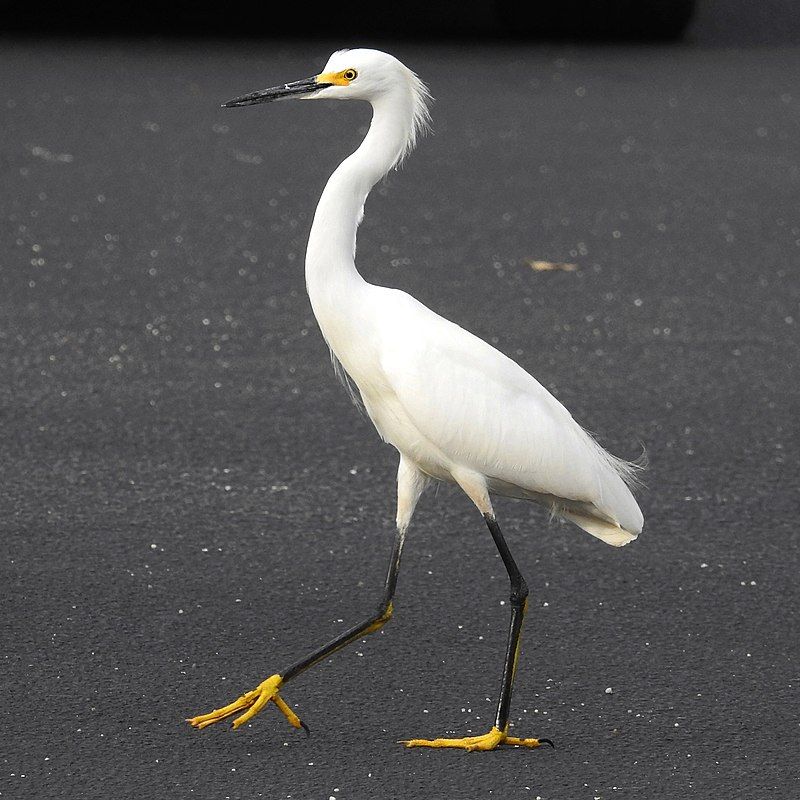
The snowy egret is a small white heron in North and South America. The genus of this bird is Egretta, derived from Provençal French for the little egret, aigrette. This is a diminutive of Saigon, the French term for heron.
This bird’s species name is thula, an Araucano term for the black-necked swan. Chilean naturalist Juan Ignacio Molina gave This name to the species in error in 1782. The snowy egret is a beautiful bird with a long neck, long yellow legs, and a white body.
It is a small heron, usually measuring around two feet in height. Its diet consists mainly of small fish, frogs, and insects.
The snowy egret is an essential species in the environment, as its presence can help maintain a healthy balance of aquatic life in its habitat. The snowy egret is a protected species in many parts of the world due to its importance as a species of conservation.
It is recognized as an essential part of the ecosystem, so its population is actively monitored and its habitat conserved. The snowy egret is also a famous bird for birdwatchers, as its unique features make it relatively easy to identify.
| Kingdom | Animalia |
| Phylum | Chordata |
| Class | Aves |
| Order | Pelecaniformes |
| Family | Ardeidae |
| Genus | Egretta |
| Species | E. thula |
10. Osprey
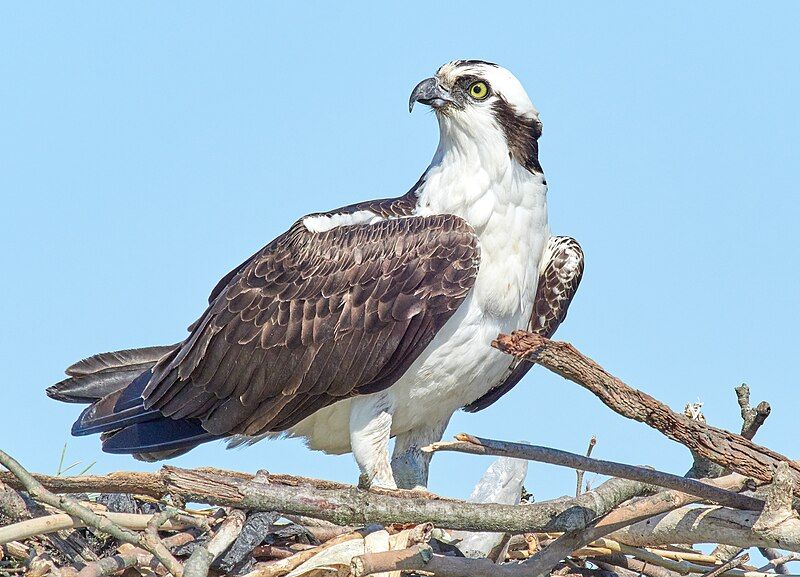
The Osprey is a bird of prey that can be found in many different regions around the world. It is easily recognizable by its large size and distinctive coloration. The Osprey is typically between 60 cm and 180 cm long, with the wingspan being much more significant than its body size.
It is primarily brown on the upperparts and predominantly greyish on the head and underparts. This bird of prey is also known as the sea hawk, river hawk, and fish hawk due to its primary fish diet.
It is a diurnal bird, meaning it is most active during the day and uses its powerful talons and sharp beak to catch its prey.
The Osprey is an impressive and powerful bird of prey, and its range is quite cosmopolitan, meaning it can be found in many different parts of the world.
| Kingdom | Animalia |
| Phylum | Chordata |
| Class | Aves |
| Order | Accipitriformes |
| Family | Pandionidae |
| Genus | Pandion |
| Species | P. haliaetus |
11. Wood Stork
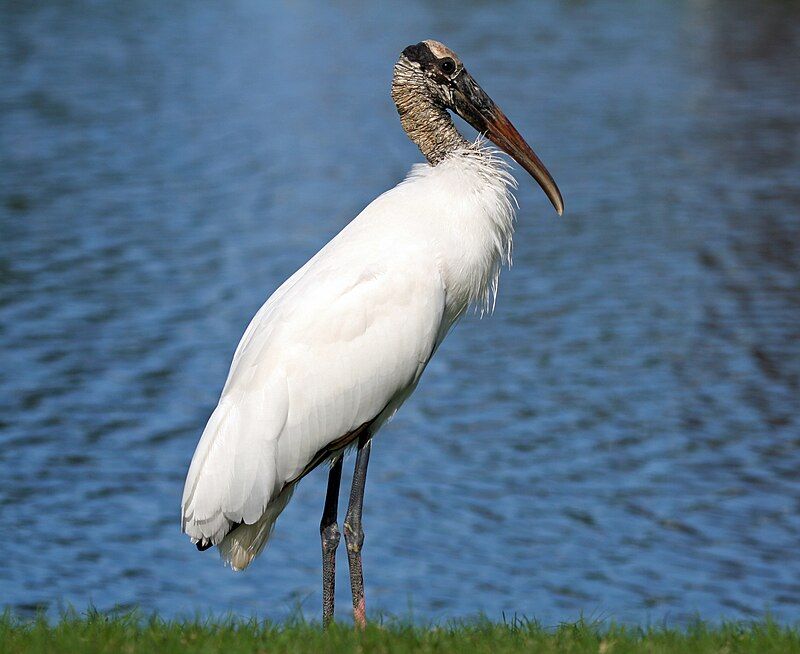
The wood stork is a prominent American wading bird belonging to the family Ciconiidae, making it the only family species to breed in North America. This bird was formerly known as the “wood ibis,” although it is not an ibis.
It is found in subtropical and tropical habitats in the Americas, including the Caribbean. The wood stork has a long, broad wingspan and stands about three feet tall. It is most easily distinguished from other birds by its bald head, black feathers, and white neck feathers.
Its long legs and wide feet make it well-adapted for wading in shallow water, and it typically feeds on fish, crustaceans, and other aquatic animals. The wood stork is an essential species in the ecosystems of the Americas.
It plays an essential role in the food chain, helping keep the fish population balanced.
It also helps disperse organic material from fish and other organisms, increasing soil fertility and the aquatic environment.
The wood stork is endangered in the United States due to various factors, including habitat loss, habitat degradation, and human disturbance.
It is estimated that only about 3,000 individuals are left in the wild. Conservation efforts are being taken to help protect this species and its habitat, including restoring wetland habitats and reducing human disturbance.
| Kingdom | Animalia |
| Phylum | Chordata |
| Class | Aves |
| Order | Ciconiiformes |
| Family | Ciconiidae |
| Genus | Mycteria |
| Species | M. americana |
12. Rufous Hummingbird
The Rufous Hummingbird is an impressive species of bird that stands out from the rest. It measures only 8 cm long and has a long, straight, slender bill.
This species is most renowned for its remarkable flying abilities, as it can fly up to 2,000 miles during its migratory transits. This species is one of nine in the genus Selasphorus, making it unique.
Its remarkable flying capabilities are made possible by its lightweight body and the ability to flap its wings at an incredible speed of up to 80 times per second. This allows the Rufous Hummingbird to soar high in the sky and travel long distances.
Additionally, the birds can hover in mid-air while they search for food with the help of their long bills. These birds are highly agile and can quickly change direction in flight, making them difficult to capture.
All of these capabilities make the Rufous Hummingbird an extraordinary species of bird.
| Kingdom | Animalia |
| Phylum | Chordata |
| Class | Aves |
| Clade | Strisores |
| Order | Apodiformes |
| Family | Trochilidae |
| Genus | Selasphorus |
| Species | S. rufus |
13. Sandhill Crane
The sandhill crane is a large species found in North America and extreme northeastern Siberia. As its name suggests, this bird is commonly found in habitats like the Platte River in Nebraska’s Sandhills.
These habitats are located on the American Great Plains and provide the perfect environment for the species to thrive. The Sandhills are a series of rolling hills and dunes that stretch across the plains, providing an ideal home for the crane.
The Platte River also offers a reliable source of food for the crane, with its large population of fish and aquatic invertebrates.
The crane has adapted to the environment of the Great Plains and is an essential species in the area, providing a unique and fascinating sight for visitors and locals alike.
| Kingdom | Animalia |
| Phylum | Chordata |
| Class | Aves |
| Order | Gruiformes |
| Family | Gruidae |
| Genus | Antigone |
| Species | A. canadensis |
Conclusion
Birds in Bolívar are an essential part of the area’s wildlife. They provide valuable ecological services, such as pollination, seed dispersal, and aesthetic and recreational benefits.
The diversity of species in the area also makes it a popular destination for birdwatchers. Conservation efforts should be made to ensure that these birds continue to thrive.